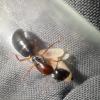All of those problems are currently being solved. ![]()
- Formiculture.com
- Forums
- Gallery
- Members
- Member Map
- Chat

All of those problems are currently being solved. ![]()
I would suggest you hibernate them, I put mine in the fridge after she stop laying eggs.
I've been thinking about it. Since I'm keeping a few of the other yet-to-be-identified Camponotus we found in the same places, I'm going to hibernate a couple of them. I only have one C. vicinus colony now though. I guess I'm just not used to hibernating my ants, and I feel like something bad will happen. ![]()
Well yeah, the Lasius no doubt. Those have to be hibernated.
Update 11-4-2014
The colony with one worker died. The other colony is still doing fine, and was put in the fridge for hibernation the other day. Chromerust gave me another all-black C. vicinus queen with just a few cocoons, and no workers. He was tired of taking care of it, so I gladly took it. If and when its workers eclose, I will also put it in the fridge for hibernation.
Drew, I looked through this journal and found something about how to catch a nuptial flight basicly, I would like for to explain more in depth, because I have missed a lot of flights. Can't they fly like the day after it rains?
Update 11-22-2014
The last workerless C. vicinus being kept in a test tube died. Yesterday I put the all-black C. vicinus that Chromerust gave me in the fridge for hibernation.
Update 11-22-2014
The last workerless C. vicinus being kept in a test tube died. Yesterday I put the all-black C. vicinus that Chromerust gave me in the fridge for hibernation.
It seems like a lot of your Camponotus died very recently, or did you just happen to update all your Camponotus journals at once? Do you think it could be related to anything?
Camponotus vicinus, Crematogaster 1, Crematogaster 2, Formica francoeuri, *, *, Myrmecocystus testaceus, Novomessor cockerelli, Pheidole hyatti, Pogonomyrmex californicus, Pogonomyrmex rugosus, Solenopsis invicta
Nah it was just coincidence. The two without workers were sure to die eventually; they didn't seem very healthy, and once they lose all their workers and stop producing, that's usually what happens next. The C. fragilis was just one of those mystery deaths, clearly not having anything to do with it's environment, or workers would probably have been affected. I have queens dying all the time when I have large quantities of them. I usually only mention it when it's more significant, like the last one or something.
Update 12-7-2014
The all-black C. vicinus died while hibernating in my fridge.
Update 12-7-2014
The all-black C. vicinus died while hibernating in my fridge.
I lost track, so what C. vicinus do you have left?
Camponotus vicinus, Crematogaster 1, Crematogaster 2, Formica francoeuri, *, *, Myrmecocystus testaceus, Novomessor cockerelli, Pheidole hyatti, Pogonomyrmex californicus, Pogonomyrmex rugosus, Solenopsis invicta
I have one typical C. vicinus left in a foraging container and they're in my fridge.
Update 1-16-2015
I just took this colony out of hibernation today. They all look healthy, and have a nice pile of all different sized larvae.
Update 2-27-2015
Since this colony's brood don't seem to be developing at all, so I put them back in the fridge to hibernate longer.
Update 3-17-2015
It was now been a total of over three months in hibernation for this colony, so I took them out of the fridge today. The colony looks to be healthy still. Hopefully some of their brood will develop now or the queen will lay some more eggs.
Got any recent pics? I'm fascinated by these guys!
Camponotus vicinus, Crematogaster 1, Crematogaster 2, Formica francoeuri, *, *, Myrmecocystus testaceus, Novomessor cockerelli, Pheidole hyatti, Pogonomyrmex californicus, Pogonomyrmex rugosus, Solenopsis invicta
If you ain't got a dream, you ain't got nothing.
Update 5-31-2015
The colony is not doing that great. They haven't really changed much at all since taking them out of hibernation. I think they might have lost a worker or two. Today I boosted them with a whole bunch of black C. vicinus brood, which they very enthusiastically accepted and took inside their tube.
Thursday in Mt. Baldy, California, I found another red-and-black C. vicinus queen wandering around.
Yesterday in Angelus Oaks, which is near Big Bear, California, I found four more red-and-black C. vicinus queens, and 11 all-black queens. Some of them were found under small rotted logs and rocks, and some were found wandering around. One of the black ones still has its wings.
 |
Ant Keeping →
Ant Keeping Journals →
cooIboyJ's Nylanderia vividula journalStarted by cooIboyJ , Sep 6 2025 |
|

|
|
Ant Keeping →
Ant Keeping Journals →
Ants_Dakota's Camponotus sp. JournalStarted by Ants_Dakota , Jul 13 2025 |
|

|
||
Ant Keeping →
Ant Keeping Journals →
Strickys Formica JournalStarted by stricky_ants , Jun 21 2025 |
|

|
||
Ant Keeping →
Ant Keeping Journals →
AntTx's Camponotus sansabeanus JournalStarted by AntsTx , Jun 17 2025 |
|

|
||
Ant Keeping →
Ant Keeping Journals →
RmA's 2nd Camponotus Crusade (Updated 9/21/'25)Started by RushmoreAnts , Jun 3 2025 |
|

|
0 members, 1 guests, 0 anonymous users